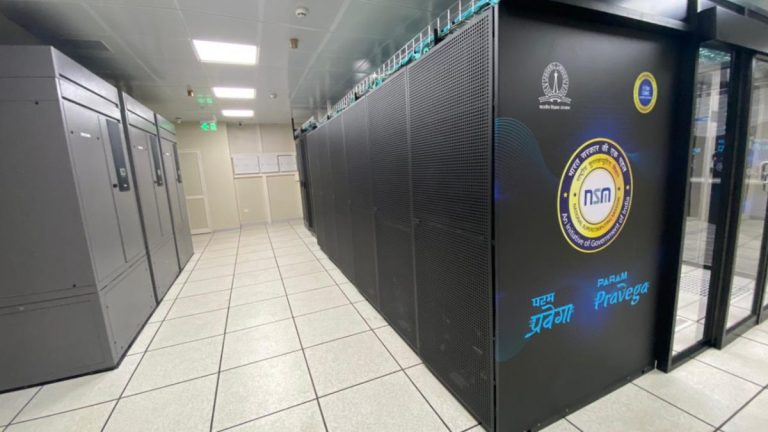|
Listen to this story
|
Developments in supercomputers started way back in 1964 with CDC 6600, and since then, there have been major breakthroughs in hardware and software that have led to a hundred times more power in these machines. The research has led scientists to build quantum computing platforms, with India listed in the top 100 list of supercomputers for many years.
In 2022, there were many announcements about supercomputers, with some new chips powering computers, new hardware that are now connected to the machines for increasing the performance, and completely new supercomputers.
Here is the list of major developments in supercomputers that happened in 2022.
PARAM Supercomputers
In January, Indian Institute of Science, Karnataka, launched India’s most powerful supercomputer, Param Pravega designed by the Centre for Development of Advanced Computing. The computer has 4 petabytes of storage and 3.3 petaflops of peak computing power. The supercomputer utilises Intel Xeon Cascade Lake processors and NVIDIA Tesla V100 cards. PARAM (Parallel Machine) has been developing several supercomputers since its inception in 1987, like PARAM 8000, which was the first Indian supercomputer, Siddhi-AI, Shivay, Sanganak, among many others. India also launched Param Ganga, its first petascale supercomputer at IIT Roorkee.
Read: A complete list of Indian PARAM Supercomputers
Tesla DOJO
On Tesla AI day, Elon Musk made several announcements, from self-driving cars to Optimus Robot, but the news about Dojo and ExaPod were the highlights. The company is exploring the opportunity to sell compute time on their Dojo like Microsoft on Azure and Amazon through AWS. Tesla demonstrated that Dojo has been outperforming other GPUs in occupancy network and auto-labelling. Tesla was previously using 5,760 of NVIDIA A100 GPUs for building FSD models, which ranked it fifth in the world with 1.8 exaflops of power.
Cerebras Andromeda
The American AI startup, Cerebras System, introduced one of the largest AI supercomputers called Andromeda. The supercomputer is basically made for academic and commercial research. The supercomputer is capable of performing one quintillion operations per second and also 1 exaflop of AI computing on a 16 bit floating point format. One of the key highlights of its release was that the supercomputer was built in less than $35 million, which is almost 10 times less than Frontier, one of the largest supercomputers from Oak Ridge National Laboratory.
NVIDIA and Microsoft Supercomputer
In November, NVIDIA announced that they are partnering with Microsoft to build the most powerful AI supercomputer utilising Microsoft’s Azure platform for building the infrastructure. The array will comprise of NVIDIA’s H100 and A100 GPUs and also include their Quantum-2 400Gb/s Infiniband for super network performance. Moreover, in their latest announcement, NVIDIA’s H100 GPU has pumped power into their high-performance computing (HPC) platform by enabling a full technology stack for AI and HPC softwares.
Read: 7 Best AI Hardware Released in 2022
AMD-powered Frontier
Frontier, the supercomputer by Oak Ridge National Laboratory powered by AMD, bagged the top spot in the Top 500 list of world’s fastest supercomputers. It is also the first true exascale system with an HPL score of 1.102 Exaflop/s. The spot was occupied by the Fugaku system, which is at Japan’s RIKEN Center for Computational Science.
Meta AI Supercomputer
In January, Meta released AI Research SuperCluster (RSC), claiming it to be one of the fastest AI supercomputers in the world. It is expected to work with hundreds of languages, analyse text and images for building better AI models. In addition to computer vision and large language tasks, Meta said that RSC will also be essential for building the groundwork for metaverse. To build the supercomputer, Meta partnered with NVIDIA to utilise 760 of their DGX A100 systems that come with 6,080 A100 GPUs linked on Quantum 200Gb/s InfiniBand for giving 1,895 petaflops of TF32 performance.
Intel Aurora
In partnership with the US Department of Energy and Argonne National Laboratory, Intel is developing the Aurora Exascale supercomputer. Intel will use their Max Series product family for providing HPC and AI computing. The supercomputer is expected to house 10,000 blades, containing six Max Series GPUs and two of Xeon Max CPUs when it comes online in 2023. Moreover, Intel is also delivering Xeon Max CPUs to Los Alamos National Laboratory and Kyoto University for development of supercomputers. Xeon Max is the first and only x86-based processor with 56 performance cores and uses 68% less power than AMD Milan-X.












































































